The timeline below is a work in progress. If you have any suggestions for dates that should be included, please complete our submission form. Items for consideration should include as much supporting material as possible (for example, a document source or webpage link documenting the occurrence) and any interesting visuals are also encouraged.
| 1810-1821 | Mexican War for Independence | |
| 1846-1848 | Mexican American War | |
| 1848 | Treaty of Guadalupe Hidalgo | |
| 1864 | May 5 | Earliest known Cinco de Mayo celebration reported in the Sacramento Daily Union on May 6, 1864 (Marquez, La Gente, 39). |
| 1868 | Mar. 23 | Charter Day - Governor Henry Haight signed act authorizing what would become the University of California. |
| 1905 | Mar. 18 | 
Governor Pardee approved “An act providing for the purchase of a University Farm for the use of the College of Agriculture of the University of California; providing for the appointment of a commission to select and purchase said farm, providing for a school of agriculture and a system of instruction on said farm, and appropriating money therefor” (Scheuring, Abundant Harvest, 15). |
| 1908 | The first “short courses began at Davis...offered by a faculty of 16 regular instructors from the College of Agriculture [UC Berkeley] and 12 nonresident instructors (including two women) selected from among leading California farmers.” (Scheuring, Abundant Harvest, 27). | |
| 1910 | Nov. 20 | Start of the Mexican Revolution (end May 21, 1920). The revolution “played a significant role in stimulating Mexican immigration to the United States, including Sacramento” (Márquez, La Gente, 41). In a profile of political science professor and future Chicano Studies Director Adaljiza Sosa Riddell, she noted that her parents left Mexico in 1919 and "because of the tumultuousness of the revolution's aftermath, were unable to return to Mexico." Third World News, May 1-7, 1972. |
| 1930 | Dec. 24 | Independent School District v. Jesús Salvatierra, 33 S.W.2d 790 (Tex. Civ. App. 1930). The first case in which Texas courts reviewed the actions of local school districts regarding the education of children of Mexican descent. Like many other communities in the state, Del Rio had for the first six decades of the twentieth century a tripartite segregation of students in its public school system. Despite a favorable ruling in district court that the segregation of children of Mexican descent was illegal, Salvatierra lost in an appeals court. Read more: Cynthia E. Orozco, “Del Rio ISD v. Salvatierra,” Handbook of Texas Online, Texas State Historical Association, accessed March 12, 2023. |
| 1931 | March | Roberto Alvarez v. the Board of Trustees of the Lemon Grove School District. Following a lawsuit filed by the parents of Mexican American grammar school children a judge ruled the Lemon Grove school district must be admitted to regular classes equally with all other children. The case, now commonly referred to as the Lemon Grove Incident, was the nation’s first recognized court-ordered school desegregation case. Read more: E. Michael Madrid, "The Unheralded History of the Lemon Grove Desegregation Case," Multicultural Education (spring 2008). |
| 1934 | The Mexican American Movement organization founded. (Their official newspaper, The Mexican Voice, began publication in 1938. The student organization of the same official incorporated in 1942.) An organization made up of college students that promoted the value of higher education among the larger Mexican American community of southern California until roughly 1950. Read more: Christopher Tudico, "Before We Were Chicanas/os: The Mexican American Experience in California Higher Education, 1848-1945," dissertation, University of Pennsylvania, 2010. | |
| 1941-1945 | 
375,000 - 500,000 Mexican Americans served in armed forces during WW2. Latinos in World War II: Fighting on Two Fronts: "At the heart of the modern Latino experience has been the quest for first-class citizenship. Within this broader framework, military service provides unassailable proof that Latinos are Americans who have been proud to serve, fight, and die for their country, the U.S. Thus, advocates of Latino equality often note that Latinos have fought in every U.S. conflict from the American Revolution to the current conflict in Afghanistan." History professor emerita Lorena Oropeza wrote an article for the National Park Service about the participation of people of Mexican descent that fought in World War II. Read the article here. | |
| 1946 | 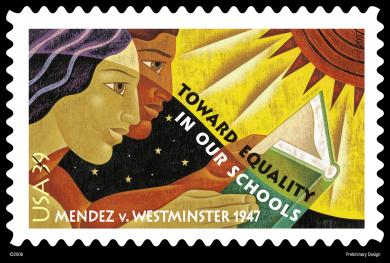
Mendez et al. v. Westminster School District et al. - U.S. District Court in southern California declared the segregation of Mexican children unconstitutional; upheld by Ninth Circuit following year; precedent for Brown decision. Read more: | |
| 1947 | Carey McWilliams, North from Mexico. “The first true history of the Mexican American” (Acuña, Making of Chicana/o Studies, 11). | |
| 1960 | California. Master Plan Survey Team. A Master Plan for Higher Education in California 1960-1975. Prepared for the Liaison Committee of the State Board of Education and the Regents of the University of California. 1960. Read more: "Context: Chicanas/os & Higher Education in California" | |
| 1962 | United Farmworkers Union (UFW) established. | |
| 1964 | Educational Opportunity Program (EOP) established. "In an effort to address the disproportionate number of low income and minority students in higher education, particularly in the four-year institutions, CCHE and the legislature authorized the implementation of the Educational Opportunity Program (EOP) in the UCs and the state colleges beginning in 1964 and 1966 respectively. EOP provided both undergraduates and graduate students an avenue by which they could overcome the racial and economic barriers that had historically blocked Blacks, Chicana/os, and other low-income people from receiving a college or university education" (Moreno, "The Chicana/o Student Movement in California’s Public Higher Education, 78). | |
| 1966 | Mar. 11 | César Chávez first visited UC Davis in 1966 as part of a Davis Friends of SNCC (the Student Nonviolent Coordinating Committee) presentation on the Delano grape-pickers strike that began the previous fall. |
| 1966 | Mar. 17 | 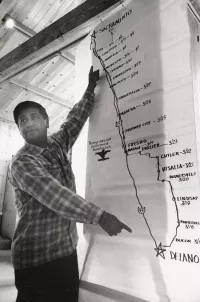
Nearly a hundred striking farmworkers, most of them Mexican American and Filipino, set out on foot from the small town of Delano, bound for the state capital in Sacramento 280 miles to the north. For six months, the farmworkers had been on strike. They refused to harvest grapes in the vineyards around Delano until the growers met their demands for higher pay, safer working conditions, and recognition of their unions. (Image: Cesar Chavez stands in front of a map detailing the route of the 1966 march. Jon Lewis Photographs of the United Farm Workers Movement. Yale Collection of Western Americana, Beinecke Rare Book and Manuscript Library.) Read more:
|
| 1967 | First Chicano Student Organization (C.S.O.) created at UCD to recruit Chicano students to UCD. Name changed to United Mexican American Students (UMAS) in 1968. | |
| 1967 | Chancellor Emil Mrak meets with Drs. Roberto Haro (Researcher at UCD’s Institute for Government Affairs) and Rosemary Pangborn (first Chicana/o professor on campus – nutrition expert) on the employment of Raza staff in admissions, and in counseling roles that eventually became part of the EOP efforts at Davis. Mrak is first Chancellor to support initiatives for La Raza. | |
| 1968 | Jan. 2 | Bilingual Education Act - "U.S. legislation (January 2, 1968) that provided federal grants to school districts for the purpose of establishing educational programs for children with limited English-speaking ability. It was the first time that the U.S. government officially acknowledged that these students need specialized instruction. The Bilingual Education Act (BEA) was an amendment to the Elementary and Secondary Education Act of 1965" (Encyclopaedia Britannica online). Laurie Kay Sommers asserts "when passage of the 1968 Bilingual Education Act caused dramatic funding increases for multicultural curricula, teachers [in San Francisco] seized upon Cinco de Mayo rather than Diez y Seis for special units on Mexican culture and history" ("Symbol and Style in Cinco de Mayo," Journal of American Folklore, Oct.-Dec., 1985: 478). |
| 1968 | March | California. Coordinating Council for Higher Education, "California Higher Education and the Disadvantaged: A Status Report (Sacramento, 1968). "Responding to the rising tide of student protest towards the low enrollment of minority students into the University of California and the California State College system, CCHE and the Joint Legislative Committee on Higher Education commissioned a series of studies to investigate the 'disadvantaged' student in higher education" (Moreno, "The Chicana/o Student Movement in California’s Public Higher Education, 75). |
| 1968 | Mar. 1-8 | 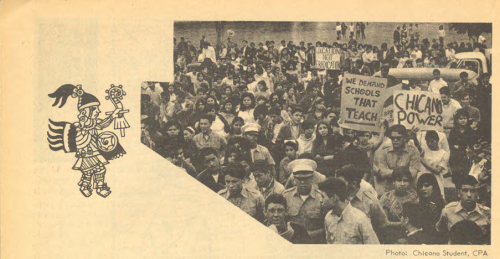
East Los Angeles Walkouts/Blowouts Read more: |
| 1968 | Mar. 21 | San Francisco College Third World Liberation Front Strike begins |
| 1968 | Oct. | "The Mexican American Student Confederation took over the office of Charles Hitch, president of the University of California system, to protest his refusal to discontinue the purchase of grapes while Chávez’s farmworkers were on strike – part of a national campaign to boycott grapes in support of the UFW" (Muñoz, Youth, Identity, Power, 85). |
| 1968 | UCD “Urban Crisis Committee” formed to develop goals and strategies for recruiting and selecting more minority students. Later that year, this committee was merged with EAP and became known as the UCD Educational Opportunity Program (EOP) | |
| 1969 | Jan. 21 | Third World Liberation Front Strike started on the Berkeley campus |
| 1969 | spring | The Black Students Union (BSU), United Mexican American Students (UMAS), and Asian American Concern (AAC) student groups submitted proposals to Chancellor Mrak to establish ethnic studies programs. |
| 1969 | March | First Chicano Youth Conference in Denver produced “El Plan Espiritual de Aztlán” (The Spiritual Plan of Aztlán), a document written by Chicano poet Alurista (Alberto Baltazar Urista Heredia) |
| 1969 | April | 
El Plan de Santa Bárbara: A Chicano Plan for Higher Education; a 155-page document, written by the Chicano Coordinating Council on Higher Education. Drafted at the University of California Santa Barbara, it is a blueprint for the inception of Chicana/o studies programs in colleges and universities throughout the US. |
| 1969 | April | Movimiento Estudiantil Chicano de Aztlán (MEChA) founded in April at the conference organized by the Chicano Coordinating Council on Higher Education at the University of California, Santa Barbara. The students envisioned the development of a Mexican American student movement that would focus on Chicana/o recruitment and retention in all levels of education. They voted to drop their former organizational names such as United Mexican American Students (UMAS), the Mexican American Student Confederation (MASC), the Mexican American Youth Association (MAYA), and the Mexican American Student Association (MASA) and become one singular organization MEChA. The adoption of the new name signified a new level of political consciousness among student activists (Márquez, La Gente, 206n107). Read more: Chicana/o Student Organizations |
| 1969 | October | Jesus Leyba appointed as “Special Assistant to the Chancellor – Chicano Affairs”. Three UCD faculty F.T.E. made available to establish a Mexican American Studies program. Gustavo Gonzalez, Gilberto Rojas, Beto Juarez. |
| 1969 | Fall | Chicano Studies Program established; UC Davis Ethnic Studies program established; Native American Studies at UC Davis began as a program, originally housed within the Department of Applied Behavioral Sciences, in the College of Agricultural and Environmental Sciences |
| 1970 | Aug. 29 | 
National Chicano Moratorium Against the Vietnam War in East Los Angeles; the biggest gathering of Mexican American demonstrators in U.S. history to that point, with about 20,000 people. Read more: Lorena Oropeza, Raza Si, Guerra No: Chicano Protest and Patriotism during the Viet Nam War Era (Berkeley: University of California Press, 2005). |
1971 | Chicanas/os in Sacramento established a chapter of La Raza Unida Party (Márquez, La Gente, 14). | |
| 1971 | Jan. 18 | Cesar Chavez speaks at Freeborn Hall. |
| 1971 | Apr. 2 | Deganawidah-Quetzalcoatl University official dedication day. |
| 1971 | Apr. 2-7 | 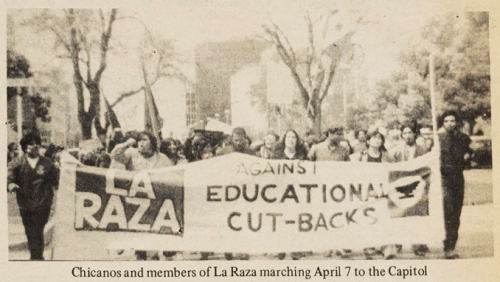
Chicano Pilgrimage to Sacramento to protest proposed cuts to EOP and greater involvement and equity in higher education. "Other reasons for the march were (1) to implement bi-lingual educational programs. (2) to bring about more Chicano representation in the educational system, (3) and to bring about Chicano community involvement in education policy-making. Read more: Aleta Fields, "Chicano's Easter Pilgrimage," Third World News, April 26, 1971. |
1972 | Chicanos in Health Education (CHE) founded from a desire by students, the community, and the American Association of Medical Colleges (AAMC) to increase the number of Chicanx/Latinx students interested in pursuing careers in the health field. Over the years, CHE at UC Davis has provided its members academic, professional, cultural and social support in order to succeed and ultimately pursue a graduate level education while also giving back to undeserved communities. | |
| 1972 | U.C. President’s Task Force begins work on report Status of Chicanos in the U.C. System, identifying paucity of numbers at all levels of faculty, staff and students. Report calls for system-wide programs of affirmative action, outreach, admissions. Committee headed by Dr. Jesus Chavarria, Assistant Professor of History and Director of the Chicano Research Center at UC Santa Barbara. Read more: "Task Force Hearing Focuses On Chicano Problems," California Aggie, November 22, 1972. | |
| 1972 | May 3 | Dolores Huerta, Vice President of the United Farm Workers Union and Cruz Reynoso, Director of the California Rural Legal Assistance speak at UC Davis as part of Semana de La Raza. |
| 1972 | Aug. 2 | Cisneros v. Corpus Christi Independent School District (467 F.2d 142), the Fifth Circuit rejected the de facto/de jure dichotomy and held that all that need be shown to establish illegal segregation is that official action had the discriminatory effect of denying equal educational opportunities to minority students. |
| 1972 | Nov. 7 | 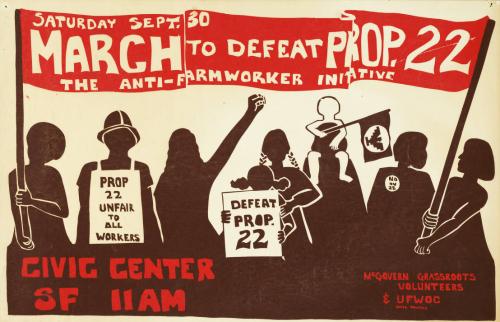
Led by opposition from the United Farmworkers Organizing Committee (UFWOC) and UC Davis organizations such as MEChA, voters defeated Proposition 22 that would have prohibited certain farmworker union activities and made it more difficult to organize. Read more: "Supporting Farmworkers" |
| 1972 | Dec. | California. California State Legislature. Joint Committee on the Master Plan for Higher Education. Chicanos and Public Higher Education. Ronald W. Lopez and Darryl D. Enos. Read more: Context: Chicanas/os & Higher Education in California |
| 1973 | May 1 | Cesar Chavez speaks at Freeborn hall |
| 1974 | Chicano Studies major created. | |
| 1975 | March | 
Chicanos in Health Education (CHE) officially opens Clinica Tepati in Sacramento (began providing services in October, 1974). Read more:
|
| 1975 | May | Chicano Task Force submits 230-page report to UC Regents concerning Mexican American underrepresentation in the UC system. |
| 1975 | Jun. 5 | Governor Edmund G. Brown, Jr., signed the Agricultural Labor Relations Act (ALRA) giving farm workers the right to bargain collectively, and establishing an Agricultural Labor Relations Board. Read more: Herman M. Levy, ”The Agricultural Labor Relations Act of 1975 - La Esperanza De California Para El Futuro,” Santa Clara Law Review15, n. 4 (1975). Available at: http://digitalcommons.law.scu.edu/lawreview/vol15/iss4/1. |
| 1975 | Nov. | 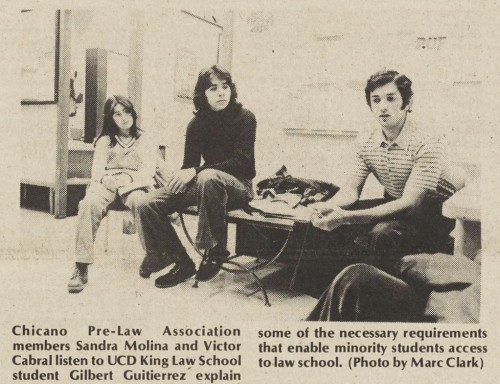
|
| 1975 | December | Chicanas/os Protest Frat Song “Lupe” performed by the fraternity Alpha Gamma Rho |
| 1977 | 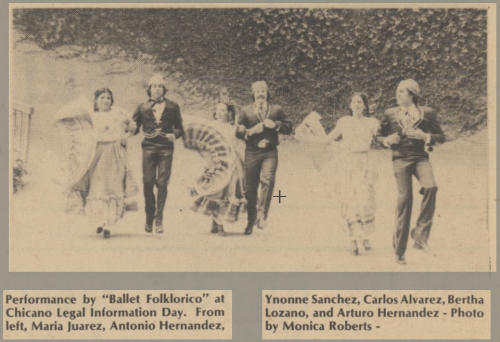
Ballet Folklorico del Alma created as a result of Chicano students' demands to the administration during the "Lupe" issue.” Read more: Jamila, ”Ballet Folklorico Expresses Chicano Culture,” Third World Forum, May 5, 1977. | |
| 1977 | May | Approximately thirty Chicanos protesting the termination of employment of Miguel Lopez, who directs the Economic Opportunity Program, staged a sit-in on the fifth floor of Mrak Hall for eight hours to register their complaints about the situation to administration officials. Lopez was eventually reinstated. |
| 1977 | Fall | D-QU receives WASC accreditation |
| 1978 | Eight social, political, and legal Latino advocacy organizations coalesce to form the Hispanic Higher Education Coalition in Washington, DC. Read more: Patrick L. Valdez, “An Overview of Hispanic-Serving Institutions’ Legislation,” in Hispanic-Serving Institutions in American Higher Education. | |
| 1978 | Jun. 28 | University of California Regents v. Bakke, 438 U.S. 265. The US Supreme Court held in a 5-4 decision that the use of race "as a definite and exclusive basis for an admission decision violated the Equal Protection Clause of the Fourteenth Amendment and Title VI of the Civil Rights Act of 1964." (The California State Supreme Court ordered UC Davis to admit Bakke in its decision in September 1976.) Read more: |
| 1979 | Hispanic Higher Education Coalition provides testimony before the House Subcommittee on Postsecondary Education (March and July 1979) and the Senate Subcommittee (October 1979) to expand Title III to include programs serving large numbers of Hispanic students. Read more: Patrick L. Valdez, “An Overview of Hispanic-Serving Institutions’ Legislation,” in Hispanic-Serving Institutions in American Higher Education, 23. | |
| 1979 | Jul. 1 | 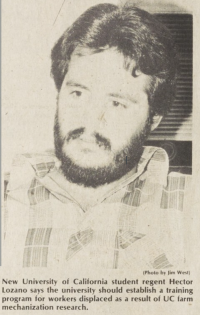
Hector Cruz Lozano student regent. "Hector Cruz Lozano, sociology major here at UC Davis, was named the fifth student regent by the UC Board of Regents. He is the first minority and the first Chicano to be selected to the Board." Read More: Carolyn R. Garcia, "Lozano Named U.C. Chicano Student Regent," Third World Forum, May 15, 1979. |
| 1979 | Oct. 26 | 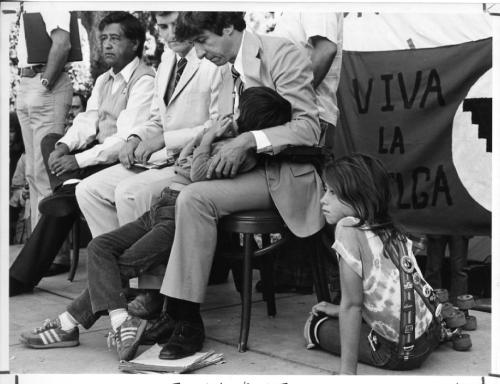
Cesar Chavez, Jane Fonda, and Tom Hayden spoke on quad to biggest crowd ever assembled. |
| 1979 | Winter | 
Lucille "Chios" Holguin was elected in the winter of 1979 as the first Chicano President of ASUCD. Read more: "Lucille 'Chios' Holgiun First Chicana President of ASUCD," Third World Forum, May 15, 1979. |

